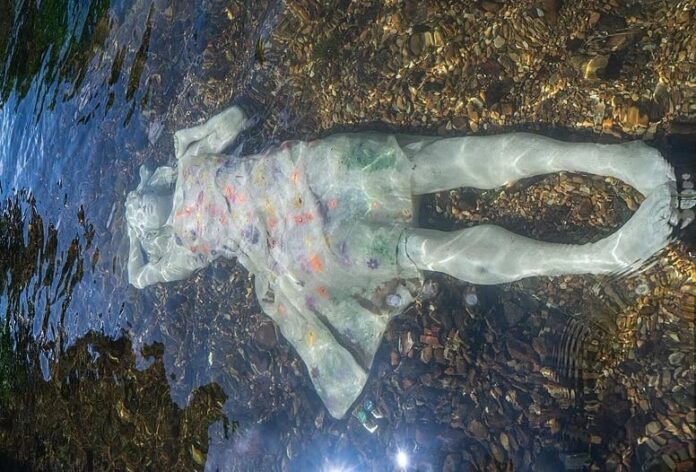Jason deCaires Taylor, the artist behind a controversial new sculpture, has expressed surprise at the negative response but welcomes the challenging discussions it may provoke. Taylor stated, “I don’t aim for my artwork to divide or cause upset. My goal is to address relevant and current issues.”
The 50-year-old artist, known for his political works, clarified that this particular piece had no political intent and was inspired by the painting that represents Shakespeare’s tragic character Ophelia. The sculpture, named The Alluvia, is crafted from recycled glass and steel and features LEDs that illuminate it at night. It was installed in the River Stour in Taylor’s hometown of Canterbury, Kent, about a week ago.
Comments on Canterbury City Council’s Facebook page have labelled the work as “tone-deaf” and “offensive.” One person remarked, “This looks like a drowned woman. How did the council not see the connection to women as victims of crime or the sad reality of refugees drowning off the Kent coast?” Another stated, “This sculpture is appalling. The imagery of a submerged figure, reminiscent of a drowning victim, is morbid and tone-deaf given the tragic drownings along our coastlines.”
A stunning new underwater sculpture in the River Stour by internationally renowned artist Jason deCaires Taylor has been unveiled and will be formally gifted to the city this weekend. Alluvia is on display on the riverbed opposite the Guildhall. More: https://t.co/273EJhaNMf pic.twitter.com/8YQRtFqGA7
— Canterbury City Council (@canterburycc) September 17, 2024
However, others defended the piece. One comment read, “More people seem to be disturbed by this artwork than by actual drownings happening daily along our coasts. Instead of hating this provocative art, why not invest that energy into something constructive?” Another supporter wrote, “It’s a beautiful piece of art and less disturbing than previous sculptures it replaced. What kind of world do we live in where anything that offends someone must be removed?”
The sculpture replaced two similar female forms, also by Taylor, which had been in the water since 2008 but were damaged due to dredging. Taylor commented, “I was surprised… 99.9% of the feedback I’ve received has been very positive… But I appreciate that everyone takes something different from what they see.”
Though Taylor insists there is no link between the sculpture and the ongoing migrant crisis along the Kent coast, he hopes it could inspire empathy for the situation in the Channel. Over 21,000 people arrived in the UK in small boats between January and September, with at least 45 people dying in Channel crossings this year.
Taylor explained that the subject is a young woman to reference Sir John Everett Millais’s famous painting, displayed at Tate Britain.
Taylor emphasised, “Art should ask questions and provoke thought. If you try to please everyone, you create something benign and pointless.” He suggested that the age of information overload might contribute to the negative feedback, with people seeking out controversy.
Most negative comments online came from individuals who had not seen the sculpture in person. One call for its removal came from Orkney. Taylor responded, “People are entitled to their opinions, but I urge them to see it first.”
Stewart Ross, Chair of Canterbury Commemoration Society, the charity that commissioned the work, said, “All public art is open to discussion. Comparing calls for removal to the destruction of art during the Reformation, he added, “If you don’t like it, don’t look.”
Ross dismissed the “confected anger” around the sculpture as “unnecessary,” stating the charity was merely “trying to do its best.” He added, “People have compared it to a dead body, but I have yet to meet a dead body that lights up at night.”
Taylor, with over 25 years of experience, has sculptures in marine locations worldwide, including Australia, Mexico, Grenada, and Norway. Prices for his sculptures start at around £1,300. He first donated the original Alluvia figures to Canterbury in 2008.
What Other Media Are Saying
- Yahoo News: Artist Jason deCaires Taylor defends his “disturbing” sculpture, stating it’s not intended to cause upset but aims to discuss significant issues, amidst a surprising backlash. (Read more)
- LADBible reports on an artist’s sculpture resembling a drowned woman, emphasizing the artist’s intention was not to distress, but rather to create a thought-provoking piece. (Read more)
Frequently Asked Questions
Here are some common questions asked about this news
Who created the controversial sculpture in Canterbury?
What is the sculpture in Canterbury made of?
Recycled glass and steel.
Why do some people find the sculpture offensive?
They believe it resembles a drowning victim.
What inspired the sculpture according to the artist?
A painting of Shakespeare’s tragic heroine Ophelia.
What does the artist hope the sculpture will inspire?
Empathy for the migrant crisis.



